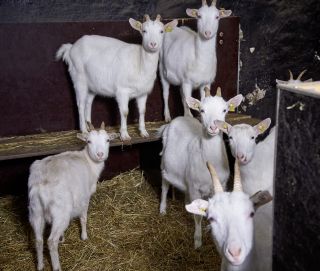Animal Behavior
Goats Are Not Stupid
What we know about goat cognition.
Updated June 16, 2023 Reviewed by Gary Drevitch
Key points
- Goats were the second animal species that was domesticated.
- Studies from the last decade show that goats have sophisticated cognitive skills.
- In some tests, goats show cognitive skills similar to domestic dogs.

One species I have not mentioned here yet is the goat, although there are more than 924 million of them on the planet – and yes, they are smarter than you think. Actually, the first cognitive test I was involved in was with goats: We tested whether they follow the gaze of other members of their species (conspecifics). At the Leipzig Zoo, helping another student, I stood in a goat enclosure with a bucket of food. We then waited for two goats to stand opposite from each other, so that one goat could see us (the “looker”) while the other (the “subject”) was turned away from us, looking at the “looker”. Then we would raise our arm to indicate that we were going to throw some food. The “looker” was interested and stared at us. The question was: What would the “subject” do? If it was able to follow the gaze of the looker – maybe understanding that it saw something interesting – then it should turn around. And that is what subjects did (Kaminski et al 2005)!
Since that experiment, researchers have found out a lot more about these ruminants. Goats were domesticated about 10.000 years ago, the first species we domesticated after the dog. Just like dogs, but in contrast to apes and monkeys, goats use the human pointing gesture to locate hidden food (Kaminski et al 2005). They also can distinguish a friendly human face from an angry one (Nawroth et al 2018). Some goats can even master the shell game: Two cups are placed in front of them. They see how one is baited with food. Then the cups are moved, so that the locations are switched. Some goats are able to follow the baited cup and choose it at the new position. Thus, in that task goats outperform dogs (Nawroth et al 2017).
Asking for Help
In another study, it was investigated whether goats ask for help. For this, researchers used a setup called the “unsolvable task”. In the task, food is placed in a plexiglass box with a lid. In the first trials, the problem is solvable, as the lid is simply placed on top of the box. The animal can push the lid away and eat the food. But then – suddenly – the box is closed tight. Wild animals, like wolves, are very persistent and try to solve the problem on their own. But goats are domesticated – and what they do is ask for help.

In the unsolvable task, there is always a human. Goats behave like most dogs here: They turn around and look at the human, and then they look back to the box. I am sure you would also know what to do, no matter whether a dog or a goat would ask you for help in that way: You would open the box for her or him. But goats don’t just look at any human, they look preferentially at humans who can perceive their signal. They do not seek help from humans whose backs are turned and cannot see them. They go for the ones who are looking at them (Nawroth et al 2016).
Goats are also performing well in a detour task, which is when the gate of a fence is moved somewhere else (Raoult et al 2021). They are neophilic, which means they can deal better with unknown situations than many other animals. In a recent study, food was hidden in a strange, unknown cup. Thirteen species of hoofed mammals were tested, but only goats and some camels approached and opened the cup (Caicoya et al 2023).
Thus, as Christian Nawroth, a leading goat researcher, puts it: Goats show high flexibility when faced with changing foraging and environmental conditions, as well as dynamic social settings. And he also has practical advice: If we are to promote good welfare, goats require at least some opportunity to utilize their cognitive capacities (Zobel & Nawroth 2020). Thus, goats should be housed in an enriched environment. Who could argue with that?
References
Caicoya, A. L., Schaffer, A., Holland, R., von Fersen, L., Colell, M., & Amici, F. (2023). Innovation across 13 ungulate species: problem solvers are less integrated in the social group and less neophobic. Proceedings of the Royal Society B: Biological Sciences, 290(1996), 20222384. doi:doi:10.1098/rspb.2022.2384
Kaminski, J., Riedel, J., Call, J., & Tomasello, M. (2005). Domestic Goats, Capra hircus, Follow Gaze Direction and Use Social Cues in an Object Choice Task. Animal Behaviour, 69(1), 11-18. doi:10.1016/j.anbehav.2004.05.008
Nawroth, C., Albuquerque, N., Savalli, C., Single, M.-S., & McElligott, A. G. (2018). Goats prefer positive human emotional facial expressions. Royal Society Open Science, 5(8), 180491. doi:doi:10.1098/rsos.180491
Nawroth, C., von Borell, E., & Langbein, J. (2016). ‘Goats that stare at men’—revisited: do dwarf goats alter their behaviour in response to eye visibility and head direction of a human? Animal Cognition, 19(3), 667–672. doi:10.1007/s10071-014-0777-5
Nawroth, C., von Borell, E., & Langbein, J. (2015). Object permanence in the dwarf goat (Capra aegagrus hircus): Perseveration errors and the tracking of complex movements of hidden objects. Applied Animal Behaviour Science, 167, 20-26. doi:10.1016/j.applanim.2015.03.010
Raoult, C. M. C., Osthaus, B., Hildebrand, A. C. G., McElligott, A. G., & Nawroth, C. (2021). Goats show higher behavioural flexibility than sheep in a spatial detour task. Royal Society Open Science, 8(3), 201627. doi:doi:10.1098/rsos.201627
Zobel, G., & Nawroth, C. (2020). Current state of knowledge on the cognitive capacities of goats and its potential to inform species-specific enrichment. Small Ruminant Research, 192, 106208. doi:https://doi.org/10.1016/j.smallrumres.2020.106208


